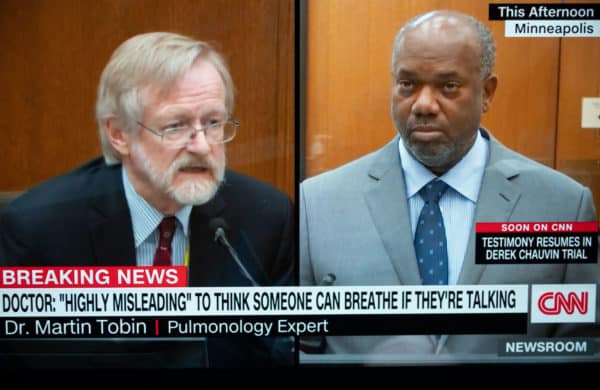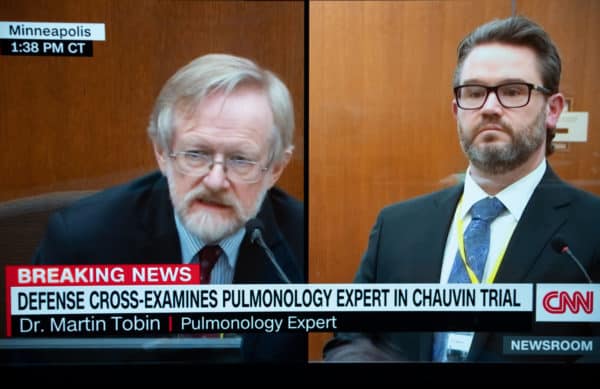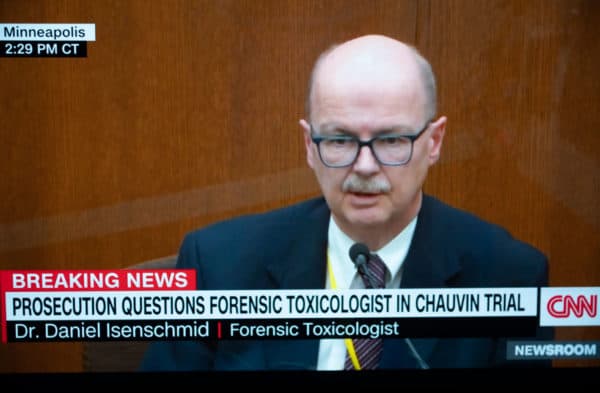The Derek Chauvin Trial — Day Nine
Anastasia Katz, American Renaissance, April 9, 2021
Editor’s Note: See our coverage of the first day of the trial here, the second day here, and the third day here, the fourth day here, the fifth day here, the sixth day here, the seventh day here, and the eighth day here.
Day nine was all about how George Floyd died — the most important question in this case. The prosecution called Dr. Martin Tobin, a pulmonologist with impressive credentials. Prosecution lawyer Jerry Blackwell noted that the medical journal The Lancet calls Dr. Tobin’s book on mechanical ventilation (breathing) “the Bible.”
Dr. Tobin has been a paid expert witness in medical malpractice cases. When the prosecution contacted him about this trial, Dr. Tobin offered to waive his usual $500 an hour fee, because he has not done a criminal case before.
Mr. Blackwell asked Dr. Tobin what he thought George Floyd’s cause of death was. The doctor answered, “Mr. Floyd died from a low level of oxygen, this caused damage to his brain, and it also caused a PEA [pulseless electrical activity] arrhythmia, and that caused his heart to stop.” The doctor explained that other terms, such as asphyxia and hypoxia, all mean a low level of oxygen. He said the low level was the result of “shallow breathing . . . small breaths that weren’t able to carry the air through his lungs down to the essential area of the lungs that gets oxygen into the lungs and gets rid of the carbon dioxide.”
The doctor said several things led to Floyd’s shallow breathing: prone position, handcuffs, knee on neck, knee on back, knee on side. All this would lead to shallow breaths. He also said many times that pressure from lying on pavement, instead of something soft, like a mattress, also made it hard for Floyd to expand his lungs.
The jury got a lesson in lung anatomy. “Dead space” is the part of the lung air travels through before reaching the alveoli, the tiny air sacs where oxygen enters the blood. Incidentally, in severe cases of Covid-19 — and Floyd was positive — the alveoli don’t work properly.
Although both the police officers’ positions and George Floyd’s position changed, Dr. Tobin said that Mr. Chauvin’s left knee was on Floyd’s neck for more than 90 percent of the nine minutes and 29 seconds Mr. Chauvin had a knee on him. Mr. Chauvin’s right knee was on Floyd’s back for 57 percent of time, and at other times it was on Floyd’s arm or “rammed in against” the left side of Floyd’s chest. The doctor said this would all have similar effects on Floyd’s breathing.
Dr. Tobin explained that when a person breathes, the chest expands both front-to-back and side-to-side. A photo shows Mr. Chauvin’s hand pushing down on Floyd’s wrist, while it was handcuffed behind his back. Dr. Tobin said the pressure against Floyd’s back prevented the front-to-back movement that Floyd needed to breathe. Dr. Tobin said that in the case of Floyd’s left side, it was “as though a surgeon had gone in and removed the lung,” so he was totally dependent on his right lung.
Dr. Tobin used photos from the scene to argue that Floyd was using his fingers and knuckles to push up against the street and the squad car’s tire to try to open his chest. He said Floyd was lifting his shoulder to try to get more breathing room.
Dr. Tobin said that the knee on Floyd’s neck was extremely important because it kept air from getting through to the lungs. The hypopharynx is a very narrow part of the throat that has no cartilage to protect it from compression. The doctor said that at different times in the video, he could see Mr. Chauvin putting pressure on Floyd’s hypopharynx. If the hypopharynx is completely blocked, oxygen deprivation will cause a seizure or a heart attack within seconds.
When Floyd rolled his head face down against the street, the doctor thought he was trying to get leverage to expand his chest. This released some of the pressure on the hypopharynx. When Floyd’s head was to the side, there was greater pressure on the hypopharynx. Once the airway is 85 percent blocked, it takes much more effort to breathe, and at some point, a person can’t breathe anymore.
Dr. Tobin pointed to a moment when Mr. Chauvin’s toe does not touch the ground, suggesting that much of his weight was on Floyd’s neck area. The doctor calculated the weight on Floyd’s neck at that moment as 86.9 pounds. The sides of the neck expand as a person inhales, but the doctor said it doesn’t really matter whether Mr. Chauvin’s knee was on Floyd’s back, neck, or side. Any position, in combination with the pavement, could lead to shallow breathing.
The doctor explained that when we exhale, we do not exhale all of the oxygen from our lungs; we have a reserve. He used an illustration to show what are called the End-Expiratory Lung Volume (EELV) and the Residual Volume (RV). “The EELV is now really squashed down by the combinations of turning him prone and also having the knee on the back,” Dr. Tobin explained. “You’re seeing a 43 percent reduction in the EELV, which means, there is also a 43 percent reduction in his oxygen reserves, which means there is also a huge reduction in the size of the hypopharynx, because this is directly linked to the hypopharynx.”
The doctor talked about how hard Floyd’s body was working to keep breathing. “When you’re turned prone and with the knee on the back, now the work that Mr. Floyd has to perform becomes huge . . .with each breath, he has to fight against the street; he has to try to fight with the small volumes that he has; then he has to try to lift up the officer’s knee.” Dr. Tobin said that the other officer pushing down against Floyd’s handcuffed hands also pushed Floyd’s chest against the ground. “There is a huge increase in the work that Mr. Floyd was performing just to cope with what was happening below the neck, let alone what is happening above the neck.”
Dr. Tobin said that when the level of oxygen reaches 36, a person loses consciousness. George Floyd, a 46-year-old man, had a normal level of 89. Floyd lost consciousness at about 8:25pm. Dr. Tobin, who works in an intensive care unit, said he can tell by looking at a patient’s face whether the patient has lost consciousness. After Floyd blacked out, the amount of oxygen in his body went to zero in less than a minute. Mr. Chauvin lifted his knee off Floyd three minutes and two seconds after Floyd’s air supply was completely gone.
The doctor was aware of Floyd’s pre-existing medical conditions from the autopsy report, but said they made no difference. Nor did it make any difference that Floyd had been fighting police officers for 10 minutes. “A healthy person subjected to what Mr. Floyd was subjected to would have died.”
Dr. Tobin said Floyd’s paraganglioma tumor was not important because “one of the key things about a paraganglioma is that it’s called the ’10 percent tumor.’ This means 10 percent of the people with paraganglioma secrete extra adrenalin (which would have made Floyd’s condition worse). Well, that could be important, but 90 percent of them don’t secrete adrenalin.” The doctor added that when someone dies from a paraganglioma, it’s a sudden death. There are six reported cases of people with paraganglioma who died suddenly, but those people complained of headaches, and Floyd did not. Dr. Tobin said Floyd’s death was not sudden.
The doctor said it was important to note when Floyd was able to speak. He said that while Floyd was speaking, there was enough oxygen to keep his brain alive. However, he said that “if you can speak, you can breathe” is “a very dangerous mantra.”

Pulmonology Expert, Dr. Martin Tobin, is questioned by prosecuting attorney, Jerry Blackwell, during the trial of former Minneapolis police officer Derek Chauvin. (Credit Image: © Pool Video Via Court Tv via ZUMA Wire)
“It’s a true statement, but it gives you an enormous false sense of security. At the moment that you are speaking, you are breathing, but it doesn’t tell you that you are going to be breathing five seconds later.” The doctor elaborated, saying that people speak only when they are exhaling. There must be inhalation before you speak. Floyd was talking for 4 minutes and 51 seconds, so his airway was not fully blocked for that period of time.
There is a moment in the video that shows Floyd’s leg kicking up backwards. The doctor said this is an involuntary reaction that indicates a fatally low level of oxygen going to the brain. “The brain is only 2 percent of our body weight but it takes 20 percent of our oxygen supply. . . . If you stop the flow of oxygen to the brain, you lose consciousness in eight seconds.”
On cross-examination, defense lawyer Eric Nelson said, “MPD officers have nowhere near your level of expertise . . . they are not even EMTs.” He said that while the doctor had the luxury of slowing down and repeatedly looking at the video — “literally hundreds of times” — the police were making decisions in real-time, based on far less medical knowledge.
Mr. Nelson said that the physics were constantly changing and could be different at each moment. Of the mathematical calculations the doctor made, Mr. Nelson said, “You’ve taken this case, and you literally boiled it down to a nanosecond.” Dr. Tobin disagreed, saying that he had given a chronology.
Mr. Nelson pointed out that Dr. Tobin is not a pathologist and doesn’t look at everything the way a pathologist would, but the doctor disagreed. “A pathologist is looking at the nanosecond of death.”
Doctor Tobin had mentioned that the back of the neck is very hard and can withstand pressure. Mr. Nelson asked the doctor if Mr. Chauvin’s knee had been on that spot, and the doctor conceded that “at times” it was.

Pulmonology Expert, Dr. Martin Tobin, is cross examined by defense attorney, Eric Nelson, during the trial of former Minneapolis police officer Derek Chauvin. (Credit Image: © Pool Video Via Court Tv via ZUMA Wire)
The defense tried to turn the doctor’s negative view on If you can speak; you can breathe to his advantage, by pointing out that even doctors keep that expression in mind as they work. Doctor Tobin insisted that it’s a bad concept to teach police officers. Mr. Nelson also prompted Dr. Tobin to admit that the calculations he presented in court assumed an equal weight distribution on Mr. Chauvin’s right and left leg.
Mr. Nelson asked Dr. Tobin if Fentanyl can cause death from low oxygen. The doctor said it can, but that it puts patients into a coma. Doctor Tobin calculated Floyd’s breaths per minute from the part of the video in which Floyd was still breathing. He said Floyd’s breaths were too frequent to suggest that Fentanyl was causing respiratory failure. Mr. Nelson brought up the pill fragments that had been found in the back seat of the squad car in which Floyd had spent some time. If Floyd had swallowed Fentanyl-and-methamphetamine pills before getting onto the pavement, wouldn’t they reach peak effect in about five minutes? Dr. Tobin had to agree that they would.
The next witness for the prosecution was Daniel Isenschmid, a forensic toxicologist, who tested Floyd’s blood and urine. He compared their chemical contents to those of thousands of other patients, both living and dead. He said the concentration of drugs in blood may appear higher if the blood is taken after the patient dies.

Forensic Toxicologist, Dr. Daniel Isenschmid, testifies during the trial of former Minneapolis police officer Derek Chauvin. (Credit Image: © Pool Video Via Court Tv via ZUMA Wire)
He had lots of charts showing that George Floyd’s Fentanyl levels were low compared to other samples in his database, but on cross-examination, Mr. Nelson pointed out that the findings presented for deaths with Fentanyl included patients who had died of other causes and the data were not limited to people who had died of recreational Fentanyl overdose. For all anyone knew, they could all have been shot dead or died in car crashes and were then found to have Fentanyl in their systems.
Dr. Isenschmid also compared Floyd’s Fentanyl levels to living people who were in DUI cases. Some were driving with higher levels of Fentanyl than were found in Floyd’s blood. Dr. Isenschimd called that “pretty amazing,” suggesting that Floyd’s Fentanyl level need therefore not be fatal. The doctor said the amount of methamphetamine in Floyd’s blood was about what someone with a prescription for the drug would take. There was morphine in Floyd’s urine, but he said it can stay in urine for a few days after someone takes morphine. He also found that Floyd smoked tobacco and marijuana and drank coffee.
Dr. Bill Smock, an emergency medical doctor with a specialty in forensic pathology, was hired by the state to testify for $300 an hour. He is a police surgeon, who accompanies SWAT teams in case someone gets hurt. He mostly just agreed with Dr. Tobin: “Floyd died of positional asphyxia. He died because he had no oxygen in his body.”
State brings in Dr. Bill Smock an emergency medicine physician with specialized training in forensic medicine. pic.twitter.com/4IKsZpT3MV
— Callan Gray (@CallanGrayNews) April 8, 2021
Dr. Smock said he ruled out other causes of death, including excited delirium, a controversial diagnosis not recognized by the American Medical Association or the American Psychiatric Association. He showed a chart of symptoms of excited delirium and said that Floyd did not have any of them.
He did not think Floyd died of an overdose because he didn’t think Floyd looked sleepy or lost awareness of where he was or what was happening. The doctor also did not see other signs of Fentanyl overdose, such as constricted pupils.
Dr. Smock talked about “air hunger,” which means being desperate to breathe. He told the court that saying “I can’t breathe,” is a sign of air hunger. In an opioid overdose, there is no air hunger because the patient falls asleep and then goes into a coma. The doctor said he never saw an opioid overdose in which someone had air hunger and cried out in pain.
On cross-examination, Dr. Smock conceded that methamphetamine — which Floyd had in his system — when combined with an opioid such as Fentanyl would produce a different kind of death from one caused exclusively by Fentanyl.
This was a good day for the prosecution. Its witnesses said what they were supposed to say and stuck to their guns. However, cross-examination was limited to subjects that came up on direct examination, so Mr. Nelson could not introduce new facts that were useful for the defense. The real test will come when the defense puts on its own experts, who will make a different case for how Floyd died. The trial continues on Friday.















